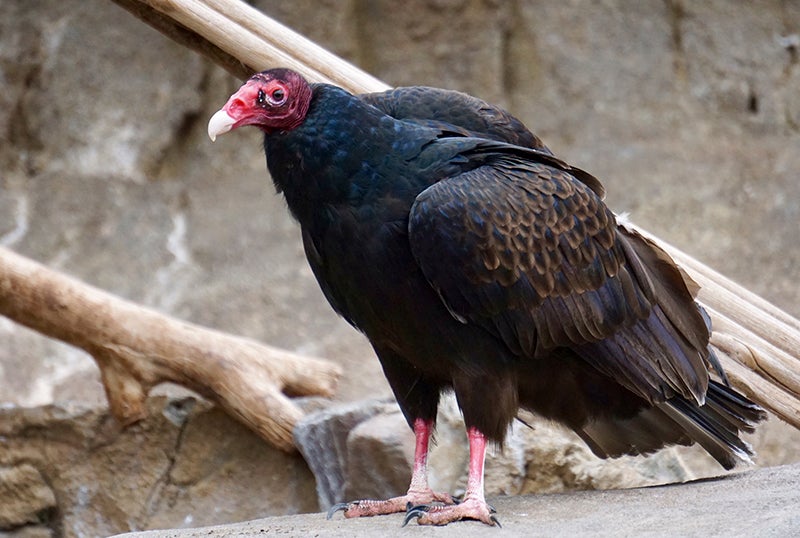Al Batt: Butterflies must work to keep warm, turkey vultures to keep cool
Published 4:37 pm Friday, November 10, 2017

- Turkey vulture by Al Batt
My neighbor Crandall stops by.
“How are you doing?” I ask.
“Everything is nearly copacetic. I stopped at the Moose Club.”
“Member?” I say.
“Of course, I remember. I just told you about it. One of the guys there said that he’d seen a bear in northern Minnesota. I remember the first time I saw a bear. I was like Sesame Street’s Big Bird when he first saw the alphabet. He thought it was one long word. I thought the world was one big bear.”
“Have you ever gone bear hunting?” I ask.
“No, but I went Buffalo hunting once. It was back when I drove a truck. I left Cleveland with a bad map. I didn’t think I’d ever find Buffalo.”
Naturally
I was there because they couldn’t cure stupid. The best they could do was to sedate it. I was in bed, smiling with a tear in my eye. I had just had surgery and was no longer a free-range hick.
Ruth Lynch of Decorah dropped off a gift for me while I was in Methodist Hospital in Rochester. It was the delightful book, “Audubon’s Birds of America: The National Audubon Society Baby Elephant Folio,“ edited by Roger Tory Peterson and Virginia Marie Peterson. It had all 435 of Audubon’s hand-colored engravings in exquisite reproductions. It was a hernia-inducing-sized book.
My nurse said, “You are not to lift this!”
She made one of those “I mean it” faces.
I was under certain restrictions due to the surgery. I was not supposed to lift anything over 10 pounds. My bride had to carry the huge book to the car and then to our house for me. Thank you, Ruth, for your kindness. Thank you, Gail, for carrying my book and my heart.
Back at home, I was pleased that the blue jays in my yard were noisy and the juncos, like many members of the sparrow family, were eating seeds on the ground.
Birdzilla sent me this. From the “Bent Life History” series we have the following description of the Blue Jay. “The blue jay is a strong, healthy-looking bird, noisy and boisterous. He gives us the impression of being independent, lawless, haughty, even impudent, with a disregard for his neighbors’ rights and wishes: like Hotspur, as we meet him in Henry IV, Part I.”
Q&A
“How cold is it before monarch butterflies are unable to fly?” Butterflies are cold-blooded, which means that their bodytemperatures aren’t self-regulated. A butterfly’s body temperature is affected by its surrounding temperatures. Butterflies can fly in temperatures as cool as 55° F, but they must regulate their body temperatures and stay warm by behavioral tactics such as shivering their wings or basking in the sun.
“I listen to your radio show and heard you talking about a vulture urinating on itself. Is that true?” Turkey vultures sometimes urinate on their legs and feet. This behavior is called urohidrosis (sometimes spelled urohydrosis) and is done in order to cool themselves. When the waste fluids evaporate, they cool the blood vessels in the feet, lowering the bird’s temperature. It’s believed that the high acidity of the urine also destroys bacteria on the legs.
“Where did all the starlings in my yard come from?” Eggs. Their numbers are high now because the young of this year are part of the flocks. Starlings are nomadic at this time, so they could show up anywhere, including your yard.
“How did buckthorn get its name?” Common buckthorn got its name from the fact that when buds are opposite. They resemble a deer hoof.
“Are insect numbers declining?” I’ll let Professor Dave Goulson of Sussex University in the U.K. answer this one for me.
“Insects make up about two-thirds of all life on Earth, but there has been some kind of horrific decline,” Goulson said. “We appear to be making vast tracts of land inhospitable to most forms of life, and are currently on course for ecological Armageddon. If we lose the insects then everything is going to collapse.”
His research, published in the journal “Plos One,” is based on the work of many amateur entomologists across Germany. Tents called malaise traps captured over 1,500 samples of flying insects at 63 nature reserves. Each sample was measured, revealing a startling decline. The annual average had fallen 76 percent over a 27-year period. Goulson said that the cause is open to debate. It could be due to a lack of food for the insects, an exposure to chemical pesticides or a combination of the two.
Thanks for stopping by
“Understanding the laws of nature does not mean that we are immune to their operations.” — David Gerrold
“Take a good look at yourself before you criticize another, for what you see wrong in them, will also be a lesson for you.” — Leon Brown
Al Batt of Hartland is a member of the Albert Lea Audubon Society. Email him at SnoEowl@aol.com.


